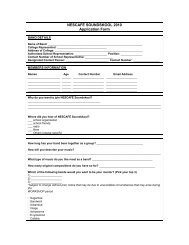Creating Shared Value Report - Nestlé Philippines, Inc.
Creating Shared Value Report - Nestlé Philippines, Inc.
Creating Shared Value Report - Nestlé Philippines, Inc.
Create successful ePaper yourself
Turn your PDF publications into a flip-book with our unique Google optimized e-Paper software.
21<br />
Conserving<br />
Water<br />
Change , %<br />
60.00%<br />
50.00%<br />
40.00%<br />
30.00%<br />
20.00%<br />
10.00%<br />
0.00%<br />
-10.00%<br />
-20.00%<br />
CONTINUOUS REDUCTION OF ENVIRONMENTAL IMPACTS since 2000<br />
<strong>Nestlé</strong> <strong>Philippines</strong> is keenly<br />
aware that water is a<br />
-30.00%<br />
life-giving resource that is<br />
-40.00%<br />
-35.59%<br />
finite and getting scarcer by<br />
-50.00%<br />
the minute. The Company<br />
2000 2007 2008 2009 2010<br />
takes water conservation to<br />
heart, leaving no stone<br />
Prod.Volume Total Water Withdrawal Rate Total Water Discharge Rate<br />
unturned in finding ways to minimize and optimize consumption, treat wastewater, and protect water sources.<br />
Optimizing Water Consumption<br />
All <strong>Nestlé</strong> worksites employ various means to use water efficiently, ever pressed to reduce consumption while increasing<br />
production. Workers are greatly involved not only in implementing water-conservation practices but more so in thinking<br />
of ways to conserve water at their level, since they are the ones who know best the conditions within which they do their<br />
job. Water-conserving ideas are thus aplenty in the worksites — mostly simple practices that cost little spending but<br />
cause a lot of savings.<br />
Among these are:<br />
• Reuse of sealing water from vacuum pumps, where the water is recirculated<br />
and used all over again as sealing water for the same vacuum pumps<br />
• Recirculation of cooling water instead of being immediately discharged to<br />
waste<br />
• Reuse of water from Reverse Osmosis plants for such purposes as flushing<br />
of toilets<br />
• Reuse of the final rinsing water during cleaning-in-place (CIP) of process<br />
equipment as initial rinsing water for the next CIP<br />
• Reuse of effluent for irrigation of plants and grass inside factory premises<br />
• Use of automatic washer for the cleaning dryer, which regulates volume<br />
of water used to clean the dryer<br />
• Insulation of steam valves and leak management<br />
• Use of sensor-operated faucets, which ensures automatic stoppage of<br />
water flow as soon as faucet use is done<br />
• Throttling of supply valve to regulate water flow<br />
• Installation of cistern tanks to collect rainwater<br />
• Use of waterless urinals<br />
Reverse Osmosis Plants<br />
55.01%<br />
-35.87%



